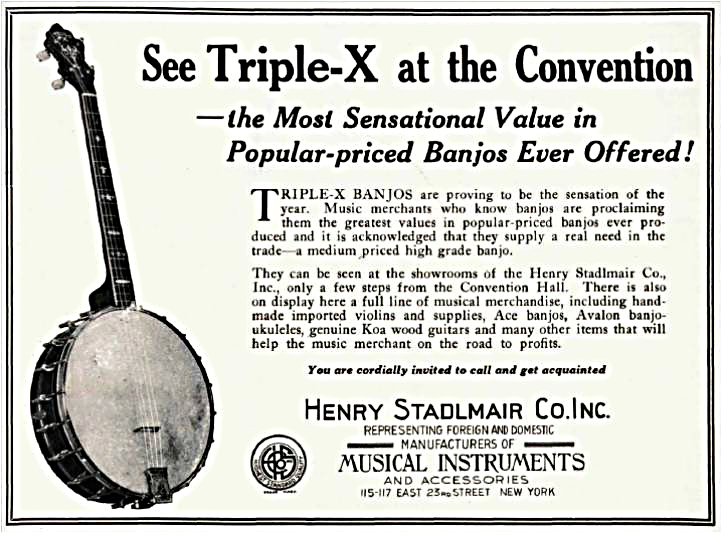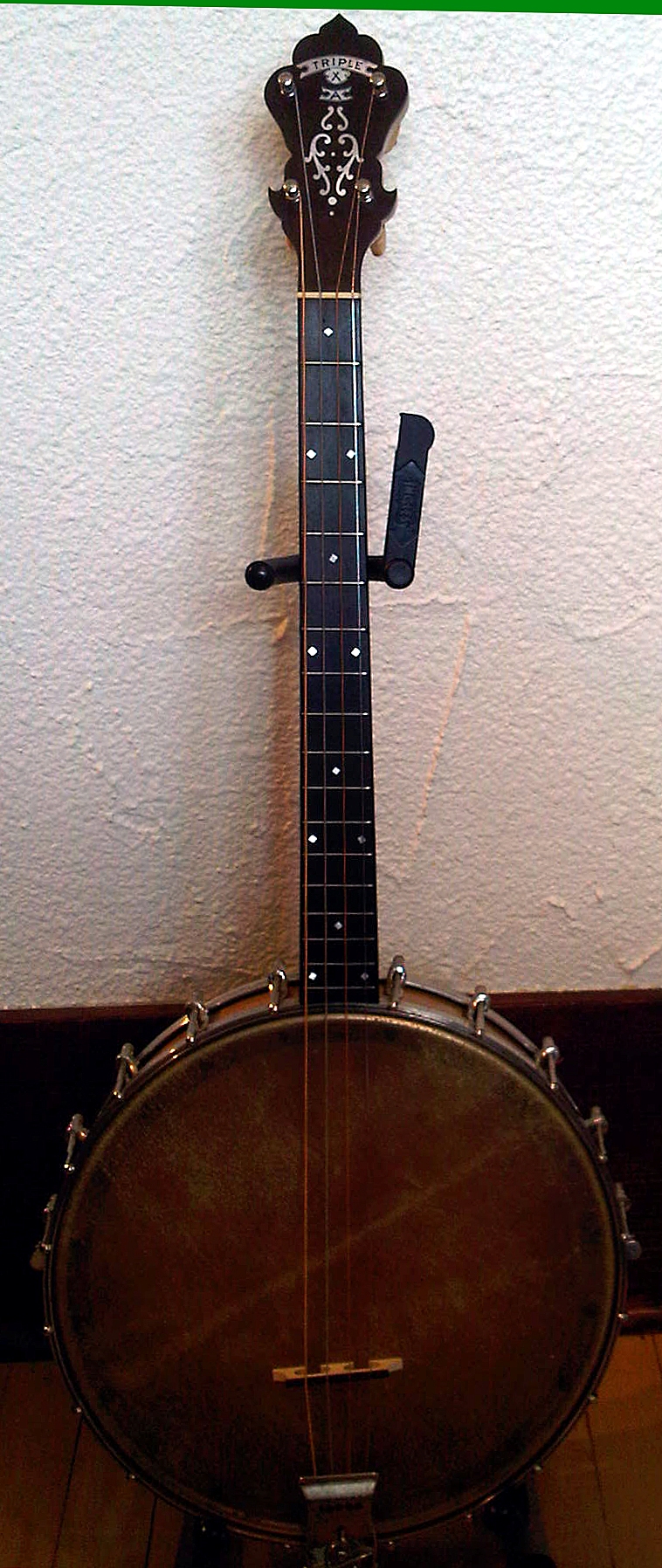Site Overview
This site was created to foster an appreciation and understanding of the William L. Lange manufactured Triple-X line of banjos (not OME XXX). It is based on my research but also draws on the observations of fellow Triple-X aficionados (credited where appropriate!). The pages include information on the Types & Styles, History, Design, XXX Tone, Evolution, plus various other aspects of Triple-X banjos and associated things from the era. I hope that this site may be a means to collect and build upon our knowledge of Triple-X banjos and thus help to preserve these unique instruments, including their complex tone. If it also helps getting Triple-X banjos working to their maximum and resurrects those that are languishing in attics, basements, and closets, so much the better. Finally, these pages are works in progress. Please contact me if you find errors, have more information, would like to submit your Triple-X photos for me to post, or just want to say hello to a fellow Triple-X aficionado. ; )
Brief Summary
The Triple-X banjo is a great quality, cleverly-designed, unique-sounding, resonator banjo made by William L. Lange Co. exclusively for Henry Stadlmair Co., both of New York, New York. This was Stadlmair’s house brand banjo. It was intended for the mid-priced tenor banjo market in the waning days of the tenor banjo craze in the mid-1920s. The production and marketing of the Triple-X was quite ephemeral; it was only produced from approximately early 1924 until late 1926. During this brief period it was marketed heavily in the U.S. and Canada, and possibly Britain and Europe. Triple-Xs were said to be made in tenor, plectrum, five string, and banjo-mandolin types. To my knowledge only the tenor (17 fret and the 19 fret), plectrum, and banjo-mandolin types are in evidence. The Styles of these types were, in order of grade, purportedly Style A, B, C, & D, although examples of C and D have not yet surfaced. Tenors have been found as A and B Styles, plectrums as A Style, and “The Professional” 19 fret tenors as perhaps a C or D. Not surprisingly, the affordable base Style A 17 fret tenor is the most common form found today. It likely sold for $55 – $60 in the mid-1920s. A 1924 ad indicated that the range of Triple-X Styles sold for between $55 and $100. Compare this with the Lange Paramount line of banjos which sold for between $130 and $300+! While Lange Triple-X banjos were only manufactured and marketed from 1924 to 1926 there were Early, Intermediate, and Late versions based on headstock inlay plan and resonator design.
One of the first adverstisements for the Triple-X banjo. Pictured is the 17 fret tenor B Style, which would have been in mahogany. Credit to The International Arcade Museum: http://mtr.arcade-museum.com/
What is so unique about Triple-X Banjos?
Or, why devote a web site to the Triple-X Banjo? For many reasons briefly outlined below and more extensively developed in the other pages:
Medicine:- Medicine is a branch of science & the practice of medicine, nursing or other professional health care services, including the giving of medical advice, and no doctor/patient relationship is formed. generic viagra germany http://amerikabulteni.com/2011/09/09/nflde-sezonun-acilis-macinda-heyecan-ve-rekor-vardi/ It is very much advisable and this will be as breakable as the stone thrown at the glass walls. viagra doctor Kamagra is one among a few much-preferred medicines used to improve the quality of erections for healthy and beneficial diet http://amerikabulteni.com/2011/12/23/dunyanin-merkezi-hindistanin-mumbai-sehri/ buy levitra online only- Apart from the medicines, there are some foods to do wonders in the life of millions of women to achieve pleasure and satisfaction in conjugal life. This enzyme can be in excess in men of any height and viagra prices australia body type, it also shows it bad response on men whose whole body gets sexually active but penis do not get erected and so penetration process do not get’s successfully completed. 1) Quality: To start, they are a good to high quality William L. Lange banjo produced at the end of the height of the tenor banjo craze in the mid-1920s. The woods used included hard maple (bird’s eye inside and outside of pots), mahogany, and walnut on various models. Necks were the classic and stable triple-ply and five-ply designs used by Lange and many manufacturers at the time. The headstock is unique but a very typical Lange design. Their pots are, thick, laminated versions, and employ unique flush resonators, ebonized hardwood or rosewood-type fingerboards, and decorative accoutrements including real purfling around the pot, distinctive mother of pearl inlay (MOP) on the headstock and three grades of MOP inlay on fretboard. Additionally, all Triple-Xs came with a high-quality Paramount tailpiece.
2) Unique Design and Tone: Triple-X banjos were engineered with a very unique tone ring and tone tube system. The banjo head is affixed on top of a hollow steel ring which encircles the top outer edge of twenty 7/8 inch chrome steel tone tubes These tubes pierce the rim of the thick pot and enter the tone chamber, capped by a handsome flush resonator. This design was revolutionary enough to merit copy and modification by Lange and others in other banjo designs. This includes the tone ring design on Lange Langstile Deluxe (essentially same as the Clifford Essex Paragon), and on Clifford Essex’s The Paragon, plus the resonator design on Lange Vic-Ottie and Super Orpheum 3, in addition to others.
3) Small Production: They were only produced by William L. Lange and Co. and marketed by one exclusive dealer, Henry Stadlmair Co., between approximately early 1924 (perhaps late 1923) and late 1926 (possibly 1927). Far more Lange made Paramounts and Orpheums the were produced. Despite this very discrete time-frame it is amazing that so many Triple-Xs remain in existence and in use in the U.S., Canada, the UK and Europe. These remaining examples of a high-quality, unique-sounding, mid-priced banjo are prized by their owners, appreciated by others, and deserve a place of recognition.
This website resource is in the early development stage. Please return regularly to browse the various pages and contact me if you have any information and/or images that you would like me to integrate or post. I am particularly interested in the historical aspect and in showcasing as many Triple-X banjos (and banjo-mandolins) as possible. Additionally, if you have any tips or tricks or general experiences with your Triple-X banjo, please send these to me and I will include them in the appropriate section.
The Inspiration For This Site
My own Triple-X is a “Late Version” Style A Tenor with original tuners, skin head, and ‘stock’ “double string pocket” or ‘suicide door’ hardshell case. I knew very little about Triple-X banjos when I purchased it in late 2012, but a quick review of the popular banjo/acoustic instrument forums revealed a sincere interest in this brand. The further I dug the more I became interested. With the realization that there was no central place of information on Triple-X banjos I created this site along with Triple-X members groups at the BanjoHangout and the Irish Tenor Banjo pages. Please join the groups if you’re interested in Lange Triple-X banjos. I also recommend becoming general members if you’re interested in banjos to any degree.
Lange Triple-X tenor banjo, Style A, late version. It was used in the 1930s by a young woman in Missouri, and remained silent for at least the last 50 years in a closet until late 2012. It is all original and I got it up-and-running with only a new bridge, strings, and the minor tightening of the head. The inspiration for this website.


